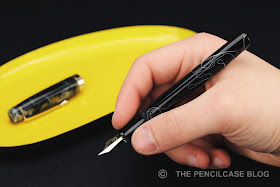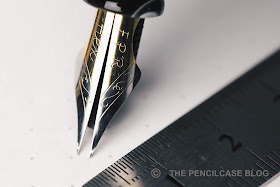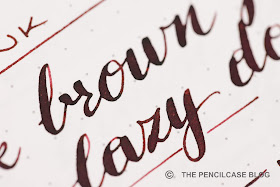
Ok. I'll admit, Indian fountain pens are a blind spot of mine. They have always been on my radar, but I didn't get around to actually trying some. It's never too late to change though, so for today, we're taking a look at an excellent option for getting into Indian pens: the Fountain Pen Revolution Himalaya.
Fountain Pen Revolution is a USA-based company that both sells Indian brands like Kanwrite, Guider, and Airmail, and also partnering with these manufacturers to create their own line of affordable, Indian-made fountain pens, sold under their own brand name. The Fountain Pen Revolution (FPR) pens start at just 7$, which is commendable on its own, but it also turns out that they have some excellent options if you're looking for an affordable flex pen... so that's more or less what we'll focus on in this review!

Just to be clear, the Fountain Pen Revolution Himalaya costs more than 7$, but it still sits at a very budget-friendly entry-level price point. You can tell that it's more expensive because they used a fancier acrylic instead of injection-molded parts. It's actually a good-looking pen, I have to say. The acrylic is a dark greyish-green with white swirls and beautiful pearlescent streaks throughout. It certainly doesn't come across as a budget pen, at least not from afar.
Looking closer though, the metal trim kind of gives away that this isn't a 100$+ pen. The finish on the center band is a bit rough, and the cap lip is a bit sharp. The bent metal clip looks and feels a bit flimsy. Although in its defense, it IS nice and springy and therefore very easy to use. This particular pen had "gold plated" trims, but the plating is not great at all, it's even just non-existent in certain areas. The plating came right off with a quick polish, and I frankly like it a lot better now that it has a uniform chrome color. Chrome trim is an option as standard, so I'd pick that any day of the week.

Apart from the mediocre metal trim, the overall build quality is actually quite good. I expect that this pen -like many other Indian pens- is made by hand, which is pretty impressive at the price point we're seeing, but it also means that it's not all as impeccable as if it were injection-molded and completely machine-made (like a Lamy Safari, for example). Even so, the build quality is quite good. Every part fits together precisely, feels solid, and has a nicely polished finish

 |
| L to R: Pelikan M805, Pilot 78G, Platinum Prefounte, FPR Himalaya, Lamy 2000, Lamy Safari. |
The Himalaya is a medium-sized pen that strikes an excellent balance between a not-too-large form factor, and still being very comfortable in the hand. It measures 13.4 cm (5.2") closed, and 12.4 cm (4.88") uncapped. Despite not typically posting my pens, this is one that does post quite comfortably without adding weight or too much length. At just 16 grams, it's a very lightweight pen. It's a fairly slender pen but the section retains a comfortable diameter and has a pleasant tapered shape. There's hardly any transition from section to barrel, and the threads are noticeable but not sharp to the touch -overall, this pen has all the right ingredients for a comfortable writing experience.
 |
| The piston is made from the typical smelly plastic you often find in Indian-made pens, and discolors quite easily. |
For this review, I was sent the first version of the Himalaya, but they made some minor improvements shortly after. Both versions one and two are currently available for purchase, but I'd recommend paying the 3 to 6 dollars extra to get the updated version.
Aesthetically, they remained completely identical, but the new version receives a more traditional screw-type converter. My review pen still has the push-pull piston converter, and it's a tricky one to get a full fill with it (even after multiple attempts). Another option would be to remove the converter altogether and use the pen as an eyedropper (some silicon grease on the barrel threads is all it takes to get a proper seal), but I'm not a huge fan of eyedroppers for daily use.
 |
| An ebonite feed, impressive on a pen this price! |
First of all, every FPR pen comes with a hand-cut ebonite feed. You'll typically only see ebonite feeds on very high-end pens, so this is a very nice thing to see on a pen this price.
The Himalaya v1 is available with a slightly smaller #5.5 (roughly the same as a #5 nib) or an upgraded #6-sized nib. The new version (v2) does away with the #5.5 nib option, which I think is a good decision because the larger nib fits the pen better, aesthetically.
Nib options are extensive: EF to M, B (+4$), stub (+4$), flex (+4$) and EF ultra flex nibs (+14$) are available in stainless steel, as well as fine, medium and flex in 14k gold (+119$). I went with the ultra flex nib for this pen because I'm currently exploring modern flex nib options (Spoiler alert, more flex pen reviews are coming in the near future!).

So what does "Ultra" flex mean? For 10$ extra, Kevin from FPR manually modifies each nib with additional cutouts on the sides of the nib and a widened ink channel on the ebonite feed. This improves the flexibility of the nib and creates a wetter ink flow that can keep up with the more demanding nib setup.
Line variation with this modified nib is impressive. VERY impressive even, down to the point where it can start to seriously compete with vintage flex -no small feat! You're looking at line variation from a western fine, to almost 2mm at the very maximum. The most impressive part is that it doesn't require nearly as much pressure as I expected. The cutouts effectively give this steel nibs a much more springy character than similar nibs without the modification, and it also seems a bit more forgiving in terms of snapback.
BUT, there is a catch! Affordable flex nib fountain pens like this one, have a reputation for being a bit finicky (think about Noodlers pens, for example), and may or may not require some work to get the most out of them. I think the nib and feed are heat-set out of the box, but I did it again a couple of times to optimize the position of the feed for the best possible ink flow. Heat-setting ebonite feeds is actually not that difficult (there are plenty of tutorials online, FPR also has instruction videos on their own website!), but it takes some time and willingness to tinker a little bit, which is not something every fountain pen user is looking for when buying a new pen.
Even when I was satisfied with the heat-set, ink flow could still sometimes behave temperamentally. Especially with heavy flex writing, it is prone to railroading and hard starting, and you can starve the ink flow when writing too fast. It's very picky about the ink you're using, the paper you're writing on, and even your writing angle... In short: there are a lot of factors that influence its behavior.
Line variation with this modified nib is impressive. VERY impressive even, down to the point where it can start to seriously compete with vintage flex -no small feat! You're looking at line variation from a western fine, to almost 2mm at the very maximum. The most impressive part is that it doesn't require nearly as much pressure as I expected. The cutouts effectively give this steel nibs a much more springy character than similar nibs without the modification, and it also seems a bit more forgiving in terms of snapback.
BUT, there is a catch! Affordable flex nib fountain pens like this one, have a reputation for being a bit finicky (think about Noodlers pens, for example), and may or may not require some work to get the most out of them. I think the nib and feed are heat-set out of the box, but I did it again a couple of times to optimize the position of the feed for the best possible ink flow. Heat-setting ebonite feeds is actually not that difficult (there are plenty of tutorials online, FPR also has instruction videos on their own website!), but it takes some time and willingness to tinker a little bit, which is not something every fountain pen user is looking for when buying a new pen.
Even when I was satisfied with the heat-set, ink flow could still sometimes behave temperamentally. Especially with heavy flex writing, it is prone to railroading and hard starting, and you can starve the ink flow when writing too fast. It's very picky about the ink you're using, the paper you're writing on, and even your writing angle... In short: there are a lot of factors that influence its behavior.

With those sidenotes out of the way, would I still buy this pen? Yes. From what I've seen and tried so far, the FPR Himalaya Ultra Flex comes extremely close to the kind of line variation you'd expect from a vintage wet noodle flex nib. That's impressive for a 49$ pen (35$ for the pen + 14$ for the ultra flex nib), no matter how you look at it.
NOTE: This product was provided by Fountain Pen Revolution, so I could write this review. I was in no way influenced in the making of this review, the opinions shared in this review are completely my own. This post does not contain affiliate links.


I have a couple of these pens with a blue Himalaya V2 on the way. I prefer the ultra flex nibs for Caligraphy. I overcome hard starts, drying out with a dash of Monteverde Fountain pen flush on the ebonite feed channel. The Jaipur V2 is a larger pen with the advantage of an ink window. Kanwrite make a Heritage model with an ultra flex nib that is also very nice pen to use. I think these Indian pens have a unique charm and character. They do demand regular use and cleaninh/flushing out.
ReplyDeleteThe Ultra flex nib really is something different! It's impressive how much line variation you can coax out of them with some patience, but indeed you sometimes need some creativity to have the ink flow keep up. I'll look into the Jaipur!
DeleteI bought many flex nibs ,both as part of a pen or separately, I have nikko g nibs,zebra g nibs,kanwrite,noodlers ,click and several FPR ,the hemalaya ebonite with the FPR 5,5 altra flex is wonderfull and stand out among all of my nibs ,I am by no mean an expert but during the pandemic I collected many fountain pins and used them intensively including dip pens and inks ,managed to make major improvement to my cursive writing and now moving into calligraphy ,i can objectively say the FPR nibs outperforms all other nibs.thanks to Kevin
ReplyDeleteBest regards from kuwait
Abdulrahman Bahman